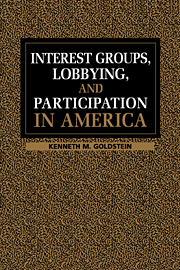Book contents
- Frontmatter
- Contents
- List of Figures and Tables
- Acknowledgments
- 1 Introduction
- 2 Patterns and Puzzles in Participation and Lobbying
- 3 The Political Logic of Political Decisions
- 4 Explaining Lobbying Decisions
- 5 Lobbying Decisions and the Health Care Reform Battle
- 6 Patterns of Recruitment and Participation in the Mass Public
- 7 Conclusion
- Appendix A Sources and Coding for Survey Data
- Appendix B Interest Group Sampling Frame
- Appendix C Chronology of Health Care Reform Legislation
- Bibliography
- Index
2 - Patterns and Puzzles in Participation and Lobbying
Published online by Cambridge University Press: 23 September 2009
- Frontmatter
- Contents
- List of Figures and Tables
- Acknowledgments
- 1 Introduction
- 2 Patterns and Puzzles in Participation and Lobbying
- 3 The Political Logic of Political Decisions
- 4 Explaining Lobbying Decisions
- 5 Lobbying Decisions and the Health Care Reform Battle
- 6 Patterns of Recruitment and Participation in the Mass Public
- 7 Conclusion
- Appendix A Sources and Coding for Survey Data
- Appendix B Interest Group Sampling Frame
- Appendix C Chronology of Health Care Reform Legislation
- Bibliography
- Index
Summary
The reigning theories of participation in American
politics, amazing as it may seem, do not have much
to say about politics. Instead, they trace activism to
the characteristics of individual American citizens,
to their educations, their incomes, and their
efficacy. They assume that attitudes determine behavior.
When asked to account for changes in
citizen involvement over the last half century, these
explanations largely fail.
Steven Rosenstone and Mark Hansen, Mobilization, Participation, and Democracy in AmericaWhen he was first elected to the Senate in 1958, the late Philip Hart of Michigan received fewer than two thousand letters on issues each month. By 1975, near the end of his Senate career, he was receiving approximately ten thousand letters per month. In a typical month in 1995, another Michigan Senator, Carl Levin, received more than twenty thousand issue letters, along with five thousand telegrams, ten thousand phone calls, and one thousand faxes.
The increase in constituent communications to Congress over the last three decades has not been confined to Michigan senators. As Figure 2.1 illustrates, there has been a dramatic increase in the amount of mail delivered to the House of Representatives over the past thirty years.
Mirroring this pattern, more than nine out of ten respondents (91 percent) to a survey I conducted of congressional offices reported record levels of incoming communications in 1993 and 1994.
- Type
- Chapter
- Information
- Interest Groups, Lobbying, and Participation in America , pp. 14 - 29Publisher: Cambridge University PressPrint publication year: 1999



